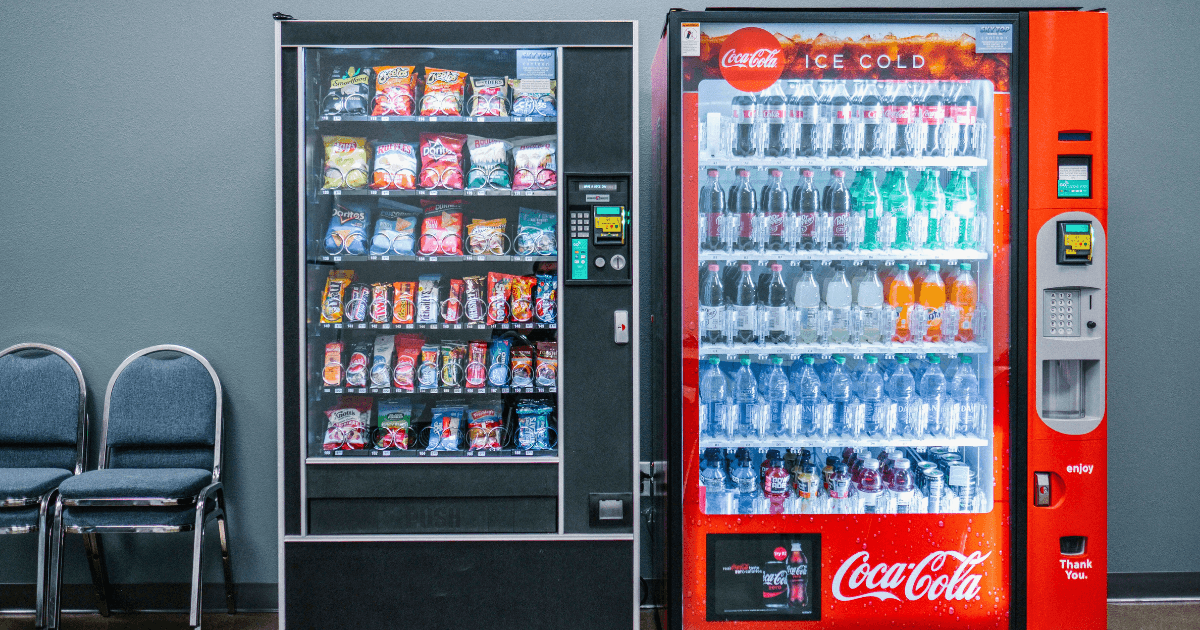Vending Machine Business: My Experience Building a 10-Machine Route That Makes $1,000/Month

In the pursuit of financial freedom, I’ve always been drawn to business models that leverage systems over constant labor. Two years ago, I took the plunge into what many consider an “old-school” passive income stream: vending machines. Today, my 10-machine route consistently generates $1,000 in monthly profit with just 15-20 hours of work.
This isn’t about getting rich overnight—it’s about building a reliable wealth-generating asset that compounds over time. In this post, I’ll share the unfiltered reality of my journey: the initial investment, location strategies, profit margins, and psychological principles that transformed this side hustle into a wealth-building machine.
The Vending Machine Opportunity in 2025
Before diving into my personal experience, let’s examine the current state of the vending industry:
- The vending machine market is projected to exceed $25 billion by 2027
- The industry is growing at a compound annual growth rate of 10% through 2030
- Over 100 million Americans purchase from vending machines daily
- Well-placed machines can generate between $300-$600 monthly profit
- Modern machines with cashless payment options see 30% higher sales than cash-only units
While not as glamorous as crypto or real estate, vending machines offer something more valuable: a predictable, scalable system for building wealth with minimal time investment.
My Vending Machine Journey: From Zero to $1,000/Month
The Initial Investment
My journey began with extensive research and a calculated investment:
Initial Capital: $13,500
- 2 refurbished snack/beverage combo machines: $6,000 ($3,000 each)
- Inventory for first stocking: $1,000
- Used cargo van: $5,000
- Business registration, permits, insurance: $1,500
Expansion Capital (Reinvested Profits): $16,000
- 8 additional machines (mix of new and refurbished): $16,000
Total Investment: $29,500
While this might seem substantial, my 10-machine route now generates approximately $12,000 annually in profit—providing a complete return on investment in less than three years.
Location Acquisition Strategy
The single most critical factor in vending machine success is location. After several failures and successes, I developed a systematic approach:
- Identify high-potential venues: Office buildings (50+ employees), manufacturing facilities, apartment complexes, hotels, and gyms
- Research foot traffic patterns: I use a simple tracking sheet to document visitor counts during different times
- Analyze competition: Existing machines, nearby convenience stores, and food options
- Prepare professional proposals: Custom presentations showing benefit to property owners
My current location portfolio includes:
- 3 machines in manufacturing facilities
- 2 machines in mid-sized office buildings
- 2 machines in apartment complex laundry rooms
- 2 machines in budget hotels
- 1 machine in a local gym
Pro tip: I offer property owners a choice between a flat monthly fee ($50-$100) or a percentage of sales (15-20%). Most choose the percentage, which aligns our incentives for machine performance.
The Financial Reality: Breaking Down the Numbers
Let’s examine the actual financial performance of my 10-machine route:
Monthly Revenue: $4,000
- Average sales per machine: $400
- Range: $250 (apartment) to $650 (manufacturing)
Monthly Expenses: $3,000
- Product cost: $2,000 (50% of revenue)
- Location commissions: $600 (15% average)
- Maintenance/repairs: $150
- Gas/transportation: $100
- Insurance/permits: $50
- Card processing fees: $100
Monthly Profit: $1,000
- Average profit per machine: $100
- Profit margin: 25%
While $1,000 monthly might not seem revolutionary, the hourly breakdown reveals the true value:
- 15-20 hours of work monthly
- $50-$66 effective hourly rate
- Completely scalable system
The Operational System: Minimizing Time Investment
To make this a true wealth-building asset rather than another job, I’ve implemented systematic processes:
- Efficient Routing: All machines are serviced in a single day each week, with locations clustered geographically
- Inventory Management: I maintain a “par level” system for products, restocking to predetermined levels
- Remote Monitoring: I’ve upgraded to machines with telemetry systems that alert me to low stock or mechanical issues
- Maintenance Schedule: Preventative maintenance every 90 days reduces emergency service calls
The key psychological principle here is creating systems that remove you from the equation—the business should operate whether you’re present or not.
Five Critical Lessons From Building My Vending Route
1. Location Quality Trumps Machine Quantity
My first three machines were placed in locations with insufficient foot traffic—a costly mistake. One machine in a prime location will outperform three machines in mediocre spots.
Implementation strategy: Develop a location scoring system based on foot traffic, competition, and demographic fit. Only place machines in locations scoring 8+ out of 10.
2. Product Selection Is Highly Location-Specific
I initially stocked all machines identically, which proved inefficient. Now, each machine’s inventory is tailored to its specific location:
- Manufacturing facilities: Energy drinks, substantial snacks, meal replacements
- Office buildings: Premium coffee, healthier snacks, kombucha
- Gyms: Protein bars, electrolyte drinks, low-sugar options
- Hotels: Travel essentials, comfort snacks, premium beverages
Implementation strategy: Track sales data religiously and adjust inventory every 30 days based on performance.
3. Modern Payment Options Are Non-Negotiable
When I upgraded all machines to accept credit cards, mobile payments, and contactless options, sales increased by 35% overnight. In 2025, cash-only machines leave significant money on the table.
Implementation strategy: Factor payment processing technology into your initial machine selection, even if it means purchasing fewer machines initially.
4. Maintenance Neglect Is a Profit Killer
Early in my journey, I operated reactively—fixing machines only when they broke down. This approach cost me thousands in lost sales and emergency repairs.
Implementation strategy: Create a preventative maintenance checklist and schedule quarterly service for each machine, regardless of apparent condition.
5. Scaling Requires Psychological Fortitude
The path from 2 to 10 machines tested my resolve repeatedly. Equipment failures, location losses, and inventory issues created moments of doubt. The psychological principle that carried me through: focusing on systems rather than results.
Implementation strategy: Before expanding, ensure your existing machines are operating with minimal intervention. Only add machines when your current route is running efficiently.
The Psychological Framework for Vending Success
Beyond the mechanical aspects of the business, specific psychological principles have proven crucial to my success:
1. The Compound Effect
Small, consistent actions compound dramatically over time. Adding just one machine per quarter allowed me to scale thoughtfully while reinvesting profits.
2. Delayed Gratification
The vending business rewards patience. My first six months generated minimal profit, but laying the groundwork for systems and locations paid dividends later.
3. The Pareto Principle (80/20 Rule)
I’ve found that 20% of my products generate 80% of my revenue. Identifying these high-performers and optimizing their placement transformed my profitability.
4. Loss Aversion Mindset
Humans are more motivated to avoid losses than acquire gains. I leverage this by focusing on minimizing waste, preventing machine downtime, and eliminating stock-outs.
5. Abundance Mentality
Rather than viewing other vending operators as competition, I’ve built relationships that have led to location referrals and equipment purchasing opportunities.
Common Pitfalls to Avoid
My journey included several costly mistakes you can avoid:
- Purchasing Too Many Machines Initially: Start with 2-3 machines and master them before expanding
- Neglecting Cash Flow Management: Separate business and personal finances from day one
- Underestimating Service Time: Each machine requires 1-2 hours weekly for proper maintenance and stocking
- Ignoring Seasonal Fluctuations: Sales can vary 30-40% between peak and slow seasons
- Failing to Diversify Locations: Different location types help stabilize income during economic shifts
Is a Vending Machine Business Right for You?
This business model isn’t suitable for everyone. Consider these factors before diving in:
Ideal for you if:
- You have $10,000+ in startup capital
- You can dedicate 5+ hours weekly to operations
- You enjoy systems optimization and data analysis
- You’re seeking supplemental income rather than immediate replacement of a full-time salary
- You have reliable transportation and storage space
Not recommended if:
- You need immediate income (expect 6+ months to reach stability)
- You lack physical capability to lift inventory (20-30 pounds regularly)
- You’re unwilling to handle occasional evening/weekend service calls
- You don’t have space to store inventory and equipment
The Future of My Vending Business
Looking ahead, my strategy includes:
- Expanding to 20 machines within 18 months
- Incorporating healthy and specialty vending options
- Implementing fully automated inventory management
- Potentially hiring part-time help for restocking
- Exploring micro-market concepts for larger locations
My goal isn’t merely more machines—it’s more profit per machine through optimization and specialization.
Start Your Own Vending Machine Business
If you’re intrigued by the potential of vending machines as a wealth-building vehicle, here’s a simplified roadmap to get started:
- Research and Planning (1-2 months)
- Study machine types and costs
- Identify potential locations in your area
- Create a business plan with startup costs
- Research legal requirements in your jurisdiction
- Initial Setup (1 month)
- Register your business entity
- Secure necessary permits and insurance
- Purchase 1-2 quality machines
- Establish supplier relationships
- Location Acquisition (Ongoing)
- Develop professional presentation materials
- Begin outreach to potential locations
- Negotiate favorable placement agreements
- Install and test machines
- Operations and Optimization (Ongoing)
- Create efficient servicing routes
- Track product performance meticulously
- Implement inventory management systems
- Build relationships with location contacts
- Growth and Scaling (After 6+ months)
- Reinvest profits into additional machines
- Refine your location selection criteria
- Optimize product selection by location
- Develop systems that reduce your time investment
Remember: The vending machine business isn’t about getting rich quickly—it’s about building a reliable, semi-passive income stream that compounds over time.
The 80/20 Summary: Key Takeaways
If you’re considering the vending machine business, focus on these critical success factors:
- Location is everything: Prioritize high foot traffic areas with captive audiences
- Start small, scale methodically: Master 2-3 machines before expanding
- Embrace technology: Cashless payments and remote monitoring are worth the investment
- Customize inventory: Tailor product selection to each location’s specific demographics
- Build systems: Create processes that minimize your time investment
The vending machine business may not be glamorous, but it offers something invaluable: a predictable path to building wealth through systems rather than constant labor.







